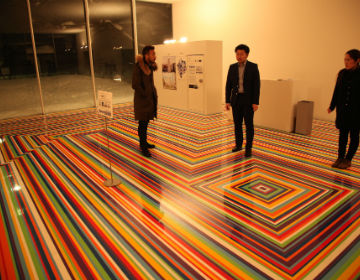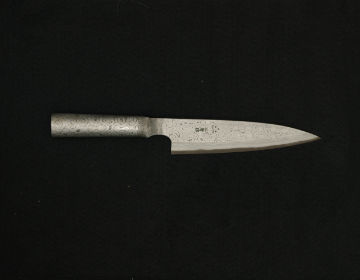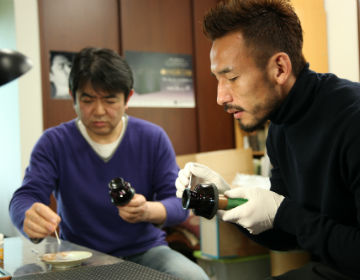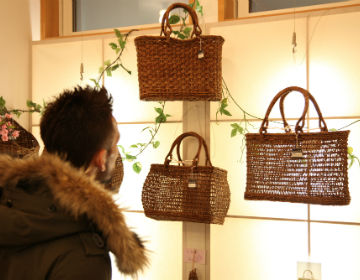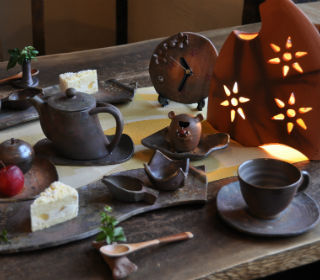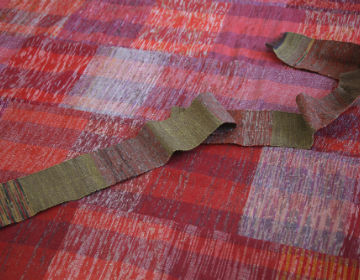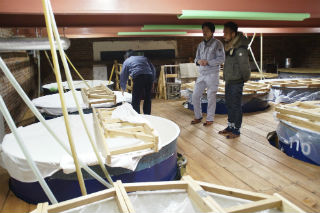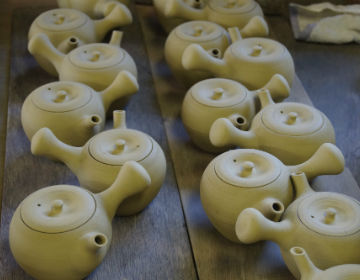Aomori– tax –
-
 TRAVEL Aomori
TRAVEL AomoriTowada Art Center
-
 CRAFT Aomori
CRAFT AomoriNigara Hamono Ltd.
-
 CRAFT Aomori
CRAFT AomoriLacquer artist, Masado Fujita
-
 CRAFT Aomori
CRAFT Aomori“Akebi vine craft Etsu Shibuya”
-
 CRAFT Aomori
CRAFT AomoriTsugaru Kanayamayaki Ceramics Cooperative
-
 CRAFT Aomori
CRAFT AomoriTsugaru Folk Hand Dance
-
 CRAFT Aomori
CRAFT AomoriNanbu Sakiori Koubou “CHOU”
-
 SAKE & Aomori
SAKE & AomoriHachinohe Shuzo Co., Ltd. (Mutsu Hassen)
-
 CRAFT Aomori
CRAFT Aomori“Hachinohe yaki” Akiyama Kiln Watanabe Pottery Studio Masaki Watanabe
12
-
 STAY Aomori
STAY AomoriHoshino Resort, Aomoriya
At ”Hoshino Resort Aomoriya” of Misawa, Aomori Prefecture, enjoy the open-air bath which is the pride of the hotel, and get smooth beautiful skin. The hotel is also convenient to tourist attractions such as Aomori, Hachinohe, Shimokita, Mt. Osorezan, Lake Towada and Oirase Mountain Stream. -
 CRAFT Aomori
CRAFT Aomori”Bokko” Shoes, K Bokko Inc., Tsutomu Kudo
”Bokko” shoes are handmade rubber boots made with natural raw rubber. Its main characteristics are warmth and durability. People in Tohoku and Hokkaido regions have been wearing them when working in the snow. The whole process from cutting to forming is done by highly skilled workers by hand, passing on what is old yet good. -
 CRAFT Aomori
CRAFT AomoriCraft Shop ”Yuzuriha”
Craft shop ”Yuzuriha” collects ”items which can be used in everyday life”. They sell handmade crafts from the Tohoku region which includes (Aomori, Akita and Iwate prefectures). -
 CRAFT Aomori
CRAFT AomoriMisawa City, Shuji Terayama Memorial Hall
It took 3 years to build Shuji Terayama Memorial Hall which stores and displays artist Shuji Terayama’s work that were donated by his mother, Hatsu, after his death. Designed by Kiyoshi Awazu, a close friend of Terayama, many people participated in building the Memorial, including Kyoko Kujo and other members of the former Tenjo Sajiki group. It opened in July, 1997. -
 CRAFT Aomori
CRAFT Aomori”Kura” style Japanese Variety Store ”Yoshimura”
First opened as a ”household utensils store, Yoshimura Shoten” in 1917, with the ”kura” warehouse which was built by the founder. In 1981, they switched from household utensils to Japanese novelty items, and the store was moved to the warehouse in 1992. -
 CRAFT Aomori
CRAFT AomoriKameya Leather Shop
Kameya is a leather shop located in the middle of a hill in the Ichibancho district. Specializing in horse riding gear since it’s foundation, the skills are now being used to make other products such as bags, hence the name ”Hermes of Tohoku”. -
 CRAFT Aomori
CRAFT AomoriTachineputa Museum
The museum stores and displays the large Tachi Neputa used at the Tachi Neputa Festival. The museum also sponsors many events such as Tachineputa building, Tsugaru craft classes, and Goshogawara Neputa Festival music practice sessions. -
 CRAFT Aomori
CRAFT Aomoriwanimokko
”Wanimokko” is a woodcraft workshop which makes made-to-order solid wood furniture and other wood products. Treating trees as nature’s gift, their goal is to use the entire tree to minimize waste. -
 TRAVEL Aomori
TRAVEL AomoriTowada City Spring Festival
In the spring, 156 cherry trees bloom all at once along a 1.1 km strip of ”Kanchogai Dori”(Koma Kaido), which was chosen to be one of ”Top 100 Streets in Japan”. The whole town is veiled in soft pink hues, and the beauty of the cherry blossoms stand out even more against the green background of 165 pine trees. Many events are held during the Festival including product exhibitions, and lighting of the cherry blossoms at night. -
 TRAVEL Aomori
TRAVEL AomoriHotokegaura
”This is a deed of God made by hands of Oni, not a place of man”. As Keigetsu Omachi read in his poem, Hotokegaura is full of unique and strange looking boulders and rocks. The place, indeed, does not look like it belongs in this world. Enjoy a panoramic view of the 2 km high Hotoke-no-Hama Buddha from the ocean. -
 TRAVEL Aomori
TRAVEL AomoriSannai Maruyama Site
Special Historical Site, ”Sannai Maruyama Site” is one of Japan’s largest Jomon period settlement sites. Studies of the natural environment and the lifestyle of the period are conducted through excavation activities. -
 TRAVEL Aomori
TRAVEL AomoriSaishoin Temple, Five Story Pagoda
The Five Story Pagoda of Saishoin Temple, designated as an Important Cultural Property, was planned by the 3rd clan lord, Nobuyoshi Matsudaira with construction started in 1656. Construction was completed in 1667. The tower is said to be the most beautiful pagoda in the Tohoku region. Although it was built in the Edo era, it retains an ancient style with a very steep shaft, giving the tower an elegant, balanced look. In the first level, only the front has a lattice window with round windows on the other 3 sides. From the second level and above, changes has been made to the design of the windows and structural materials for a different touch. -
 TRAVEL Aomori
TRAVEL AomoriTakayama Inari Shrine
Takayama Inari Shrine is said to be the most powerful miracle-working shrine in Aoyama prefecture, enshrining the god of good harvest, maritime safety and success in business. Many visit for a variety of reasons whether it be agriculture, commercial, industrial, fishery, family well-being, recovery or prevention of illness, protection during travel, warding off evil spirits, etc. The ”Thousand Torii”, which can only be seen here, is a splendor worth visiting. -
 TRAVEL Aomori
TRAVEL AomoriUtou Shrine
It is said that during Emperor Ingyo’s reign, a man named Utou Chunagon Yasukata made the Emperor angry, and was sent to live in Sotogahama Beach as punishment. While there, he had a spiritual dream of ”Takakura Myojin”. He then built a small shrine in the tideland and enshrined the Three Gods of Munakata which later became Utou Shrine. There is a collection of art pieces by Shiko Munakata such as ”Picture of Utou family, parent and child”. -
 TRAVEL Aomori
TRAVEL AomoriHirota Shrine
A prestigious shrine, and the only one to worship the 2nd generation Aomori Chief Councilor, Shindo Shobei Masatsugu Okina who promoted Aomori’s development and progress. The shrine is revered broadly across the country for enshrining a guardian deity warding off calamity, misfortune and disease. -
 FOOD Aomori
FOOD AomoriTatehana Quay Morning Market
The Hachinohe Port in Hachinohe City, Aoyama, has one of the largest catches in Japan including squid and mackerel. Located in the large Tatehana Quay”, ”Tatehana Quay Morning Market” is held every Sunday during the months of March through December, and is open from dawn. -
 FOOD Aomori
FOOD AomoriSenyou Main Store
There is no menu at the main store of Senyou in Hachinohe, Aomori, and there is only a chef’s choice course. Enjoy the fresh, locally harvested seasonal seafood and local cuisine in the style distinct to Senryou. -
 FOOD Aomori
FOOD AomoriYoshida Bakery Mont Blanc Main Store
Yoshida Bakery is synonymous with ”anbata”(sweet bean paste and butter). It was created in 1967, about 12 years after the bakery’s opening. The simple bread with sweet bean paste and butter sandwiched between additive-free bread is a heartwarming soul food. Yoshida Bakery is a hometown bakery which continues to be loved the locals. -
 FOOD Aomori
FOOD AomoriTsugaru Soba of Hirosaki, ”No no An”
”No no An” began serving Tsugaru ”soba” at the end of the Edo era when the founder, Yoshichi Sato went to Shinagawa Battery with Tsugaru clan samurai and artillerist, Yoshinori Iwata, whom he also worked for. The shop has been making Tsugaru ”soba” with buckwheat flour made from a once extinct native plant, using a traditional method. They are proud of the ”soba’s” texture and flavor. -
 FOOD Aomori
FOOD Aomori”Kiseki no Ringo” (Miracle Apples)
Following more than 10 years of experimentation, Aomori apple farmer Akinori Kimura successfully cultivated pesticide free apples, a feat which was believed to be absolutely impossible. These apples, called ”Kiseki no Ringo” or ”Miracle Apples”, became the focus of attention at the time. Kimura continues to produce apples, but also holds seminars for the next generation of instructors in natural farming methods. -
 FOOD Aomori
FOOD AomoriOsteria Enoteca Da Sasino
Sasamori, the owner of Osteria Enoteca Da Sasino, trained in Italy for 2 and a half years at two star Michelin restaurants such as ”Dorada” and ”Arnolfo”. When he turned 30, he decided to open an Italian restaurant in Hirosaki. Sasamori not only cooks his own food, but produces his own vegetables, prosciutto, cheese and wine, starting from the ingredients. This attracted attention from all over the country, leading to numerous exposure in the media. He was awarded both a gold and silver at the 2014 Japan Cheese Award. He was also was awarded Bronze Class at the ”Cooking Masters”, the cooking honor system created by the Ministry of Agriculture, Forestry and Fisheries. -
 FOOD Aomori
FOOD AomoriHomura
Homura an eatery where you can thoroughly enjoy a good drink. Preparing dishes which draw out the flavor of the many local seasonal ingredients, Homura serves many dishes which can only be enjoyed at this establishment. -
 FOOD Aomori
FOOD AomoriBanchoan
Handmade ”soba” shop, ”Banchoan” is located in the center of Hachinohe city, serving ”soba” and ”appetizers that pairs well with sake”. They serve ”kuichi soba” where the ”soba” flour and split flour are mixed at a ratio of 9 to 1. ”Gensoba” is cleaned, polished and skinned, then ground with a stone mortar to create ”soba” flour. The ”soba” buckwheat is sourced from Hokkaido, Yamagata, Akita or Aizu. The characteristic of the resulting ”soba” flour is carefully observed, to select the best combination for the best tasting ”soba”. -
 FOOD Aomori
FOOD AomoriSushi Ichi
Sushi Ichi is a first class Edo-style ”sushi” restaurant, possibly the best ”sushi” shop in Aomori. With uncompromising eye for detail, only the best ingredients are selected and prepared with ingenious craftsmanship, making this shop a first rate sushi restaurant. -
 FOOD Aomori
FOOD AomoriInageya
The tavern ”Inageya” is located one street oceanside from Aomori Hotel, a 15 minute walk from Aomori Station. Proudly serving seafood from Oomamachi, Aomori. Sometimes, the fish caught just that day is served, so you can count on having the freshest fish. -
 FOOD Aomori
FOOD AomoriSuzumeno Oyado
There is no fixed menu here. Instead, a menu is created daily to feature the seasonal flavors of Tsugaru, to accommodate the various set menus. Lunch 2,100 yen, Kaishoku Lunch 3,150 yen, Chef’s Selection Dinner (Sakura) 4,200 yen, Chef’s Selection Dinner (Neputa) 5,250 yen, Chef’s Selection Dinner (Yuki) 7,250 yen. -
 FOOD Aomori
FOOD AomoriTsugaru Roman, Koji Shirato
As the name implies, ”Tsugaru Roman” is a brand of rice being made in Aomori Prefecture. The rice is planted mainly in the central zone of Tsugaru with a view of Tsugaru Fuji, ”Mount Iwaki”, as well as the northwest region of Tsugaru, and the inland southern plains where the weather and the soil conditions are suitable. Genealogy-wise, ”Tsugaru Roman” is the grandchild of ”Koshihikari” and the child of ”Akitakomachi”. It inherits strong characterics from ”Akitakomachi” but it has a lighter, more gentle taste. -
 CRAFT Aomori
CRAFT AomoriKomise Dori
”Komise” is the name of a street which was chosen as one of the 100 Best Streets in Japan. The street has traditional buildings and a shopping arcade from the clan period which are still intact, making it a rarity in Japan. Its main feature is the covered arcade that protects people from strong sunlight and snowstorms. The street is home to ”The Takahashi Residence”, an Important Cultural Property, and old ”sake” breweries. Enjoy browsing through the nostalgic atmosphere. -
 CRAFT Aomori
CRAFT AomoriEngraving and Lacquer Artist, Hirokazu Shimamori
Shimamori studied the basics of ”Tsugaru-nuri” because he wanted to learn the traditional craftwork of his birthplace and home town of Aomori. He started a new brand of lacquerware called ”LANDPROTECT” which combines ”Tsugaru-nuri” and silver as a way to promote the history and tradition of the region, as well as to create something that would blend easily into today’s lifestyle. -
 CRAFT Aomori
CRAFT AomoriGlass Artist, Chuzaburo Ishibashi
Glass Art Studio ”Star Bridge” is headed by a glass artist, Ishibashi, and has a workshop and gallery in Hachinohe City in Aomori. Glass products are designed, crafted and finished in the studio using both traditional and their original blow glass techniques. They enjoy discovering interesting aspects of glass in their daily craftwork. -
 CRAFT Aomori
CRAFT Aomori”Tsugaru-yaki” Haruhisa Koyama
Koyama is a ceramic artist who owns and works on his own pieces at ”Tsugaru Chiyozogama” in Hirosaki City. -
 CRAFT Aomori
CRAFT AomoriCeramic Artists Shuhei Yasuda and Miyo Yasuda
Ceramic artists Shuhei Yasuda and his wife Miyo jointly opened their studio, ”polepole” 16 years ago. 10 years ago, they relocated to an abandoned house in Ajigasaki that they renovated on their own. Now they do all their creative work there, enjoying the view of Mount Iwaki. Picking up hints from their daily lives and travels, they bring unique ideas to life by creating items such as tableware made from soil and lanterns made using paper. -
 CRAFT Aomori
CRAFT AomoriA-FACTORY
A-FACTORY was established in May 2010 as a new business model for Aomori while stimulating the local economy. As part of the JR East Group’s ”Rediscovering the Region Project”, Aomori prefecture opened a facility called the ”A-Project” in December 2010 - a workshop where Aomori apples are processed into cider and juice, and a market selling local produce. -
 CRAFT Aomori
CRAFT AomoriTsugaru ”shamisen” player, Atsushi Tada
Tsugaru ”shamisen” is ”shamisen” music born in the Tsugaru region (currently the western part of Aomori prefecture). Originally, Tsugaru shamisen was played as an accompaniment to folk music from the Tsugaru region. The store owner, Tada, is a shamisen musician with 20 years of experience. He uses his vast experience and knowledge in carefully selecting products for his store. -
 CRAFT Aomori
CRAFT AomoriTazawa Cutlery Works, Kozo Tazawa
Tazawa is a third generation bladesmith who wields his hammer in a traditional workshop. Currently, he works alone in his workshop. The store has been producing and selling pruning scissors, machetes, kitchen knives, weeding scythes and apple mold removers for 100 years. The apple pruning scissors, ”Shimizu Ikkokuin”, is widely used by fruit growers all over Japan. -
 CRAFT Aomori
CRAFT AomoriTsugaru Coating (Kara-nuri, Tsugei-nuri) Shoji Wajima
Wajima devised a new pattern called ”Tsuge-nuri”, which adds a new creative technique to the traditional Tsugaru coating technique, making a brick-like pattern. Wajima was selected as a ”Modern Master Craftsman” in 2005. -
 CRAFT Aomori
CRAFT AomoriAomori Prefectural Museum of Art
This museum, opened on July 13, 2006, introduces local Aomori culture. The museum not only displays art pieces, but also holds various art and cultural activities such as movie showings, theater and music performances, providing surprise and excitement to the residents of Aomori. It is also gives residents an opportunity to expand their horizons. -
 CRAFT Aomori
CRAFT AomoriTsugaru-nuri (Monsha-nuri), Masato Kimura
When ”tsuguru ash” (in Tsugaru region, rice husk is called ”tsuguru”.) is plated onto a black lacquer pattern (mostly lines) and finished by polishing, it is called ”Monsha-nuri”. Kimura is the most prominent ”Monsha-nuri” craftsman. -
 CRAFT Aomori
CRAFT AomoriTsugaru Vidro/ Hokuyo Glass
”Tsugaru Vidro” are made from the sand of Shichirigahama Beach which spreads on the west side of the Tsugaru Peninsula. Hokuyo Glass has been creating beautiful elegant glassware using the ”blowing” technique, handed down from the 1st century BC. Enjoy the unrestricted and uniquely designed glass products made with highly skilled craftsmanship, designated as a Traditional Craftwork by Aoyama Prefectural Government. -
 CRAFT Aomori
CRAFT AomoriTsugaru-nuri (Kara-nuri), Teruyoshi Kon
The ”Kara-nuri” is representative of Tsugaru painting, and currently has the highest production in Japan. Kara-nuri has a unique complex pattern of dots which are dried, re-painted and sharpened over and over again, and involves 48 complex steps to create. Each Kara-nuri lacquerware is carefully made from start to finish, taking a minimum of one and a half months up to two months to complete. -
 CRAFT Aomori
CRAFT AomoriTree Doctor, Masaru Kobayashi
Tree doctor, Masaru Kobayashi, proactively pruned cherry tree branches when it was a taboo to do so, and succeeded in reviving the cherry trees in Hirosaki Park. In 2011, he also tried to resurrect a famous ”100 year old large weeping cherry tree” also in Hirosaki Park, which had broken very close to the root due to heavy snow. -
 SAKE & Aomori
SAKE & AomoriSaito Sake Brewery
Saito Sake Brewery began at the end of the Edo period when they made the ”shubo” or mother yeast using the family’s traditional secret recipe, selling it to all the breweries in the Tsugaru area. The water, the life of ”sake”, is spring water from Mount Iwaki of the Shirakami Mountain Range which is registered as a World Heritage Site. The spring water and quality rice from the Tsugaru plain are placed in the brewing houses which resonate with the sound of ”quena” or Andean flute. During the intense cold winter months, ”sake” is made by hand the old fashioned way, with a continued commitment to creating ”sake that is delicious and brings joy”. -
 SAKE & Aomori
SAKE & AomoriRokka Shuzo Co., Ltd. / Hanaomoi
Rokka Shuzo sticks to traditional handmade sake, which carries the ”Joppari”spirit which means ”stubborn person” in the Tsugaru dialect. They continue to provide great tasting sake infused with the passion and skill of the brewmaster. -
 SAKE & Aomori
SAKE & AomoriKikukoma Shuzo Co., Ltd/ Kikukoma
Hirofumi Miura became the 7th generation owner of the hundred year old brewery ”Kikukoma”. At the young age of 29, he continues the traditional motto of making ”sake” that is ”unchanging”. One of the reasons for the pleasant flavor of ”Kikukoma” is the M2 yeast which yields a less acidic taste and great aroma. -
 SAKE & Aomori
SAKE & AomoriHatomasamune Co., Ltd./Hatomasamune
Founded in 1899, the name ”Hatomasamune” is derived from a pigeon which nested in the brewery’s warehouse during the early Showa period and was later enshrined as a guardian angel. Underground water of Oirase River that flows from Lake Towada is used. Adhering to the motto of ”making tasty and aromatic sake”, the skilled brewers make local ”sake” with great care, sticking to the old fashioned recipe. -
 STAY Aomori
STAY AomoriHotel Nakua City Hirosaki
1 minute walk from JR Hirosaki Station. It is a city hotel located near the Hirosaki Castle, famous for the cherry blossoms, and the World Heritage Shirakami Mountains. The hotel is also equipped with a banquet hall, conference room and a chapel. The rooms, designed with pride, combine Hirosaki tradition, natural beauty and modernism. -
 STAY Aomori
STAY AomoriRichmond Hotel Aomori
Located close to where the prefectural and city facilities such as Aomori Prefectural Government and City Hall are centered. Wake up fully rested in the warm, comfortable and calming room which will provide a moment of satisfaction and induce a restful nights sleep. Because of its convenient location, the hotel is suited for a any purpose including business and leisure. -
 STAY Aomori
STAY AomoriHotel Jogakura
Hotel Jogakura is a Scandinavian-style resort hotel surrounded by virgin beech forest. In the summer, guests can cool off among the refreshing trees, while in the winter, the hotel is popular with skiers. THe hotel is located in the wilderness, surprising guests with a different feel each season. -
 STAY Aomori
STAY AomoriHoshino Resort Kai Tsugaru
Hoshino Resort World Tsugaru is a Japanese-style inn with a hot spring located in Owani, Minami Tsugaru. Guests can enjoy meals prepared with ingredients from the Aomori or Tohoku region, hot-spring baths made with ancient ”hinoki” or Japanese cypress, and the beautiful wide open space created by Japanese painter, Matazo Kayama. Great access to surrounding tourist attractions such as Hirosaki, Shirakami Mountains, Mt. Iwaki and Towada Lake. -
 STAY Aomori
STAY AomoriAXIS Grand Sunpia Hachinohe
This elegant hotel is built on a small hill overlooking the Pacific Ocean. In addition to the banquet hall and a restaurant, the hotel has a quality spring spa and 10 tennis courts, the most in the city. Guests are sure to enjoy relaxing here. -
 STAY Aomori
STAY AomoriMakado Onsen Hotel
At resort hotel ”Madoka Tourism Hotel”, enjoy the beautiful scenery of each season, quality hot springs and traditional local fisherman’s cuisine. -
 STAY Aomori
STAY AomoriOirase Mori no Hotel
The concept of the hotel is to help guests provide happiness to their travel companions. Guests can enjoy the visual stimulation and the wonderful flavors, using all five senses to fully appreciate the nature of Towada, Oirase. -
 STAY Aomori
STAY AomoriHotel Aomori
A classic hotel in Aomori City. The hotel is conveniently located for pleasure, business and weddings.



